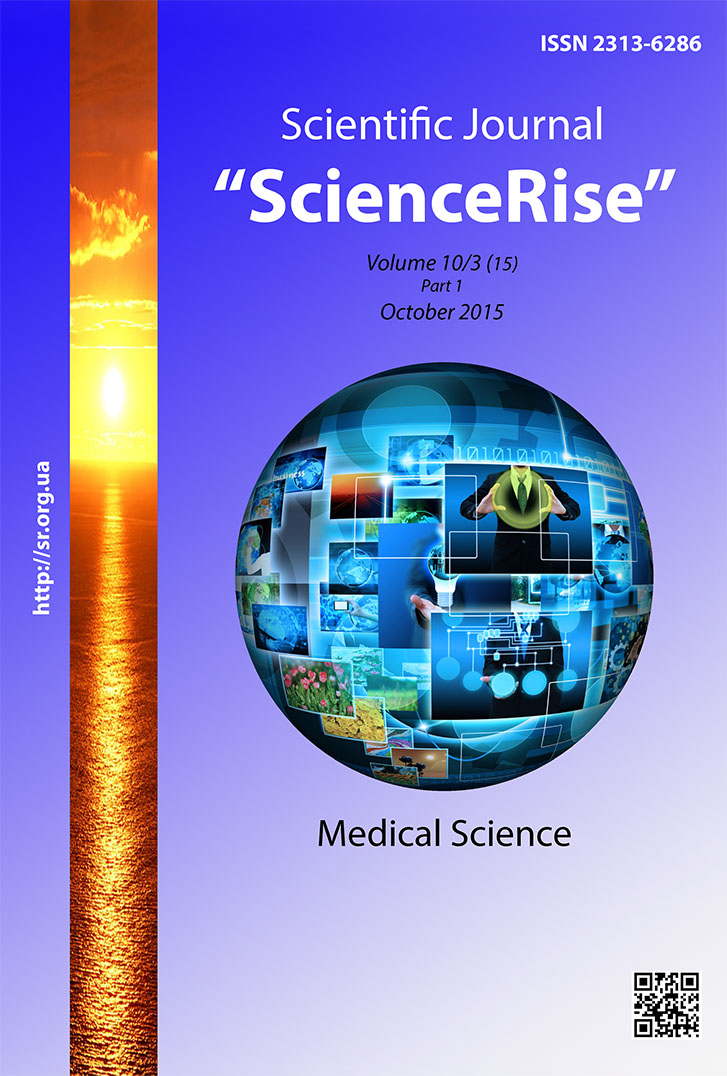Особливості спектрального складу жовчних кислот у пацієнтів з гіперурикемією в поєднанні з ожирінням та неалкогольним стеатогепатитом
DOI:
https://doi.org/10.15587/2313-8416.2015.52182Słowa kluczowe:
сечова кислота, ожиріння, неалкогольний спеатогепатит, хроматографія, біліарний садж, метаболічний синдромAbstrakt
В статті наведено дані власного спостереження і встановлено, що у пацієнтів з гіперурикемією в поєднанні з ожирінням та неалкогольним стеатогепатитом у більшому відсотку випадків зустрічається феномен «біліарного сладжу», гіпотонія жовчного міхура та зміни спектру жовчних кислот, що може свідчити про ризик розвитку холелітіазу у даної категорії пацієнтів
Bibliografia
Povoroznuk, V. V. (2009). Hyperuricemia and metabolic syndrome [Hyperuricemia and metabolic syndrome]. «Pain. Joint.Spine», 4, 47–54.
Lippi, G., Montagnana, M., Targher, G., Salvagno, G. L., Guidi, G. C. (2008). Relationship between uric acid, hyperglycemia and hypertriglyceridemia in general population. Biochemia Medica, 18 (2) 37–41. doi: 10.11613/bm.2008.005
Ludwig, J., Viggiano, T. R., McGill, D. B., Oh, B. J. (1980). Nonalcoholic steatohepatitis: Mayo Clinic experiences with a hitherto unnamed disease. Mayo Clin. Proc., 55, 434–438.
Pasalic, D., Marinkovic, N., Feher-Turkovic, L. (2012). Uric acid as one of the important factors in multifactorial disorders – facts and controversies. Biochemia Medica, 22 (1), 63–75. doi: 10.11613/bm.2012.007
Billiet, L., Doaty, S., Katz, J. D., Velasquez, M. T. (2014). Review of Hyperuricemia as New Marker for Metabolic Syndrome. ISRN Rheumatology, 2014, 1–7. doi: 10.1155/2014/852954
Adams, L. A. (2005). Nonalcoholic fatty liver disease. Canadian Medical Association Journal, 172 (7), 899–905. doi: 10.1503/cmaj.045232
Smith, B. W., Adams, L. A. (2011). Non-alcoholic fatty liver disease. Critical Reviews in Clinical Laboratory Sciences, 48 (3), 97–113. doi: 10.3109/10408363.2011.596521
Kobalava, G. D., Tolkacheva, V. V. (2005). Metabolic syndrome: treatment guidelines, RMG, 13 (7), 451–458.
Tsushima, Y., Nishizawa, H., Tochino, Y., Nakatsuji, H., Sekimoto, R., Nagao, H. et. al (2013). Uric Acid Secretion from Adipose Tissue and Its Increase in Obesity. Journal of Biological Chemistry, 288 (38), 27138–27149. doi: 10.1074/jbc.m113.485094
Yoo, T. W., Sung, K. C., Shin, H. S., Kim, B. J., Kim, B. S., Kang, J. H. et. al (2005). Relationship Between Serum Uric Acid Concentration and Insulin Resistance and Metabolic Syndrome. Circulation Journal, 69 (8), 928–933. doi: 10.1253/circj.69.928
Gutiérrez, A. M., Reboredo, G. R., Mosca, S. M., Catalá, A. (2009). High resistance to lipid peroxidation of bird heart mitochondria and microsomes: Effects of mass and maximum lifespan. Comparative Biochemistry and Physiology Part A: Molecular & Integrative Physiology, 154 (3), 409–416. doi: 10.1016/j.cbpa.2009.07.019
Baran, B. (2014). Non-alcoholic fatty liver disease: What has changed in the treatment since the beginning? World Journal of Gastroenterology, 20 (39), 14219. doi: 10.3748/wjg.v20.i39.14219
Solomentseva, T. A. (2004). Nonalcocholic steatohepatatis: mechanism of development, diagnosis, treatment. Suchasna gastroenterologija, 6 (20), 25–29.
Pavlov, Ch. S., Shylpekova, U. O., Zolotarevskyi, V. B. (2005). Sovremennue predstavleniya o patogenese, diagnostike i lecheniu fibroza pecheni. Ros.gurnal hepatologii, 2, 13–20.
Kang, D.-H., Ha, S.-K. (2014). Uric Acid Puzzle: Dual Role as Anti-oxidantand Pro-oxidant. Electrolytes & Blood Pressure, 12 (1), 1. doi: 10.5049/ebp.2014.12.1.1
Stepanov, U. M. (2006). Klinicheskie osobennosti techenia nealkogolnogo steatogepatita v zavisimosti ot soputstvyushix zabolevanij. Suchasna gastroenterologiya, 3 (29), 4–7.
Özgür, P., Hüseyin, B., Ferhat, Ç., Hüseyin, K., Nuri, D. B. (2013). Association Between Insulin Resistance and Oxidative Stress Parameters in Obese Adolescents with Non-Alcoholic Fatty Liver Disease. Journal of Clinical Research in Pediatric Endocrinology, 5 (1), 33–39. doi: 10.4274/jcrpe.825
Polimeni, L. (2015). Oxidative stress: New insights on the association of non-alcoholic fatty liver disease and atherosclerosis. World Journal of Hepatology, 7 (10), 1325. doi: 10.4254/wjh.v7.i10.1325
Choi, Y.-J., Shin, H.-S., Choi, H. S., Park, J.-W., Jo, I., Oh, E.-S. et. al (2014). Uric acid induces fat accumulation via generation of endoplasmic reticulum stress and SREBP-1c activation in hepatocytes. Laboratory Investigation, 94 (10), 1114–1125. doi: 10.1038/labinvest.2014.98
Kushiyama, A. (2014). Linking uric acid metabolism to diabetic complications. World Journal of Diabetes, 5 (6), 787. doi: 10.4239/wjd.v5.i6.787
Patterson, R. A. (2002). Prooxidant and antioxidant properties of human serum ultrafiltrates toward LDL: important role of uric acid. The Journal of Lipid Research, 44 (3), 512–521. doi: 10.1194/jlr.m200407-jlr200
Otsuki, M., Kitamura, T., Goya, K., Saito, H., Mukai, M., Kasayama, S. et. al (2011). Association of urine acidification with visceral obesity and the metabolic syndrome. Endocrine Journal, 58 (5), 363–367. doi: 10.1507/endocrj.k10e-319
Firneisz G.(2014). Non-alcoholic fatty liver disease and type 2 diabetes mellitus: The liver disease of our age? World J Gastroenterol, 20 (27), 9072–9089.
Ryu, S., Chang, Y., Kim, S.-G., Cho, J., Guallar, E. (2011). Serum uric acid levels predict incident nonalcoholic fatty liver disease in healthy Korean men. Metabolism, 60 (6), 860–866. doi: 10.1016/j.metabol.2010.08.005
Beuers, U. (2006). Drug Insight: mechanisms and sites of action of ursodeoxycholic acid in cholestasis. Nature Clinical Practice Gastroenterology & Hepatology, 3 (6), 318–328. doi: 10.1038/ncpgasthep0521
##submission.downloads##
Opublikowane
Numer
Dział
Licencja
Copyright (c) 2015 Олена Володимирівна Барабанчик

Utwór dostępny jest na licencji Creative Commons Uznanie autorstwa 4.0 Międzynarodowe.
Our journal abides by the Creative Commons CC BY copyright rights and permissions for open access journals.
Authors, who are published in this journal, agree to the following conditions:
1. The authors reserve the right to authorship of the work and pass the first publication right of this work to the journal under the terms of a Creative Commons CC BY, which allows others to freely distribute the published research with the obligatory reference to the authors of the original work and the first publication of the work in this journal.
2. The authors have the right to conclude separate supplement agreements that relate to non-exclusive work distribution in the form in which it has been published by the journal (for example, to upload the work to the online storage of the journal or publish it as part of a monograph), provided that the reference to the first publication of the work in this journal is included.

